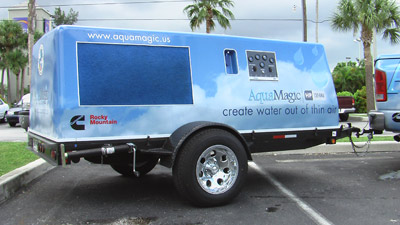There’s water around us all the time, we just can’t see it. The air in our atmosphere contains a varying amount of water vapor, depending on the weather. When it’s hot and humid, evaporated water can make up as much as 6 percent of the air we breathe. On cold, dry days it can be as low as .07 percent of the air’s makeup.
This air is part of the water cycle, an Earth process. Crudely put, water evaporates out of rivers, lakes and the ocean. It’s carried up into the atmosphere, where it can collect into clouds (which are actually just accumulations of water vapor). After the clouds reach the saturation point, water droplets will form, which we know as rain. This rain runs off the land and collects into bodies of water, where the whole process begins again.
The problem is, the water cycle goes through dry periods. Because of this, some inventors have begun to wonder, why wait? Why not pull the water vapor right out of the air?
One Australian inventor has done just that. Max Whisson is the creator of the Whisson Windmill, a machine that uses wind power to collect water out of the atmosphere. Whisson points out to the Australian Broadcasting Corporation that water vapor amounts to about “10,000 billion litres [about 2,600 billion gallons] in the bottom kilometere [about .62 miles] of air around the world” [source: ABC]. What’s more, this water is replaced every few hours as part of the water cycle.
Whisson’s windmill uses refrigerant to cool the blades of his mill, which he’s named Max Water. These blades are situated vertically rather than diagonally, so that even the slightest breeze turns them. The cool blades cool the air, causing the water vapor to condense — become liquid water again. This condensation is then collected and stored. Whisson’s windmill can collect as much as 2,600 gallons of water from the air per day.
Whisson says that his biggest challenge isn’t the engineering behind his invention but finding the venture capital to back it — he says that people think it’s too good to be true. This problem would sound familiar to a pair of American inventors who have a water-making invention of their own.
Jonathan Wright and David Richards have created a machine that’s similar to Whisson’s, except that it resembles a collapsible pull-behind camper more than it favors a windmill. This invention — which its creators call AquaMagic — pulls air directly from the area surrounding it. Inside the machine, the air is cooled via a refrigerated coil. The air condenses, and the water is collected, purified, and released through a spigot.
The AquaMagic machine — which currently cost about $28,000 per unit — can produce up to 120 gallons of purified water in 24 hours, and since it’s small it can be toted to disaster sites and Sub-Saharan Africa alike. But it also has one drawback: To produce this much water, AquaMagic requires about 12 gallons of diesel fuel. It’s here that the Whisson Windmill (which runs about $43,000 per unit) has a clear advantage over AquaMagic: It’s totally green. It runs exclusively on wind power, requiring no fossil fuel. Even the condenser runs off the power generated by the windmill’s turbines.
Speaking of the environment, why go to the trouble of collecting water out of the air? Why not simply cause more rain to fall? It may sound far-fetched, but this is actually done — at times, with catastrophic consequences.
Source: https://science.howstuffworks.com/
Dear User/Visitor! Please, answer on our questions: tick off one of the positions – your answer will make us able to improve our site and make it more interesting and useful!


